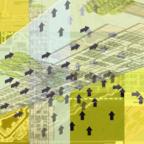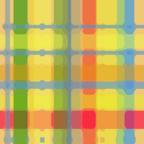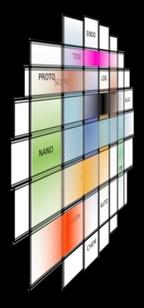Luminous

Alex Norman, Media Arts and Technology
Kim Stoltzfus, Communications

The California Nano-Systems Institute design, "Luminous", has an interactive feel; allowing those working inside the building and those traveling by to impact how the design is displayed. This interactivity concept relates to the importance of the reciprocal relationship between citizen users and technology designers. These themes, which are drawn from communication theory, are described as follows:
Weaving a Tapestry:
A unique alliance of shared cultural and
technological interests of the different disciplines involved in this research.
The Disclosure of Innovation at Work:
Outside observers are not just
looking at a building wall, but rather an illumination, a window into to the
activity of the building and a reflection of their involvement.



The new California Nano-Systems Institute (CNSI) building is a gateway to the campus, pronouncing its importance through its massive size and modernity, and thereby potentially leading passers-by into questioning the mysterious, innovative research going on behind its walls. Within the CNSI building, prominent research on Nano-technology, the cell-size innovation that is receiving much media attention as of late, will be conducted through a unique partnering of scholars from several science and art disciplines. These scholars will examine the technical, social, cultural, and ideological impacts of this technology.
Tape Loops:The design itself consists of several "tape loops" of various lengths and widths which move independently. Each loop is made of a clear material that fades into a color and fades back out to clear while the loop moves. Some of the loops will contain text fragments. Each loop is driven by a separate computer controlled motor which allows for each loop to move independently. There are 2 groups of loops, one that moves horizontally and one that moves vertically. Only the front side of the loop will be viewable. The motors that drive the loops will be placed behind the installation.
Weaving:
The loops are woven together in the typical over-under pattern common in weaving. The loom/loops are a reference to historical computer innovations, early electronic music, as well as "weaving" of knowledge which will provide for future innovations. When the loops move the text on them will be "woven" and new words will be created. Here are two sketches of the weaving mechanisms: side view sketch and top view sketch. As can be seen in the sketches, roller guides will be used to mechanically weave the loops over and under each other.
Allosphere outline:
The loops will be oriented so that their outline form a digitized circle like pattern. The circle is an outline of the Allosphere, a space made especially for multidisciplinary interaction, which is right behind the wall. The piece will be back-lit at night allowing for viewing at all hours as well as providing a different feel for the piece at different times of day.
Sensors:
Radio Frequency IDs will be placed on each loop to allow for computer tracking of the loop position. The motion of the loops will be determined by sensors that will detect the activity within the building (Network Activity, Electricity Usage, Sound and Video activity within the Allosphere) as well as activity outside the building (car motion tracking). This will provide an "window" into the building as well as an interactive component.
Mechanical:
Besides the aesthetic quality of a mechanical loom structure, having a mechanical, physical systems allows for the loom be visible in most lighting situations. We also don't have the air traffic control interference issues that might result from an electronic display. We wanted our image to be tangible and for the interaction to be physical, which we believe strengthens the interactive appeal. Obviously, a mechanical device requires more maintenance than an electronic display, but both have finite life times. We hope to mitigate any environmental damage and repair requirements through clear encasing.
Practical:
As this is a mechanical system, there are potential concerns about the noise of the rotations interfering with the work within the building and allosphere. However, we think that mechanics will actually be fairly unintrusive. Again, the basic components are simply a series of rollers attached at various points along the width and height of the wall. These rollers rotate the tape loops at varying speeds across the installation. Links to some manufacturers of custom roller technologies are listed below.
Venturi, Scott Brown & Associates
Turing Machine
Charles Babbage's Analytical engine
Musique concrète
Media Arts and Technology at UCSB
Ada Lovelace
Conway's Game of Life
Jacquard loom
Industrial Rollers:
RotaDyne
Chin Chen Wheel Industrial
Mitex Steel Inustrial
Translucent Fabric:
Adorama
Dazina
Decorativelaminates